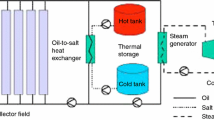Abstract
A high temperature heat transfer fluid in a solar thermal power plant is used to receive and take the heat from the solar concentrator and then give to another fluid (such as water or air) in a thermal power cycle. With regard to their thermal and transport properties, high temperature heat transfer fluids such as synthetic oil, various molten salts, and liquid metals are different. Therefore, a general criterion is needed for evaluation of the merit of fluids regarding their transport properties. The present work considers the system entropy production as the criterion to define figure of merit (FOM). For the required amount of heat transfer rate in a heat transfer system, the fluid with properties that make the system entropy production the minimum is considered to be a winner. The system entropy production includes two parts, due to heat transfer (addition and removal) and pressure loss in the heat exchangers and fluid circulation pipes. Analysis and relevant equations are presented in this work. Several heat transfer fluids known well-known in solar thermal industry including synthetic oils, molten nitrate salts, and halide salts are compared using this standard.
Access this chapter
Tax calculation will be finalised at checkout
Purchases are for personal use only
Preview
Unable to display preview. Download preview PDF.
Similar content being viewed by others
References
Jon T. Van Lew, Peiwen Li, Cho Lik Chan, Wafaa Karaki, Jake Stephens, Analysis of Heat Storage and Delivery of a Thermocline Tank Having Solid Filler Material general on thermal storage, Journal of Solar Energy Engineering, MAY 2011, Vol. 133 / 021003–1.
XCELTHERM® 600 Engineering Properties, Radco Industries, (http://www.radcoind.com/).
Therminol VP-1, http://www.solutioa.com
Manohar S. Sohal, Matthias A. Ebner, Piyush Sabharwall, Phil Sharpe, Engineering Database of Liquid Salt Thermophysical and Thermochemical Properties, March 2010, Report # INL/EXT-10–18297, by Idaho National Laboratory Idaho Falls, Idaho 83415.
R. W. Bradshaw and N. P. Siegel (2008). “Molten nitrate salt development for thermal energy storage in parabolic trough solar power systems,” Proceedings of ES2008, Energy Sustainability 2008, August, 10–14, 2008, Jacksonville, FL, pp 1–7.
A. Baraka, A. I. Abdel-Rohman, and A. A. El Hosary, (1976). “Corrosion of Mild Steel in Molten Sodium Nitrate-Potassium Nitrate Eutectic,” British Corrosion Journal, 11(1), 43–46.
Yu-ting Wu, Nan Ren, Tao Wang, Chong-fang Ma, Experimental study on optimized composition of mixed carbonate salt for sensible heat storage in solar thermal power plant, Solar Energy 85 (2011) 1957–1966.
K. Vignarooban, P. Pugazhendhi, C. Tucker, D. Gervasio and A.M. Kannan, Corrosion Resistance of Hastelloys in Molten Metal-Chloride Heat-Transfer Fluids for Concentrating Solar Power Applications, Solar Energy 103 (2014) 62–69.
J. Pacio, Cs. Singer, Th. Wetzel, R. Uhlig, Thermodynamic evaluation of liquid metals as heat transfer fluids in concentrated solar power plants, Applied Thermal Engineering, Volume 60, Issues 1–2, 2 October 2013, Pages 295–302.
J. Pacio, Th. Wetzel, Assessment of liquid metal technology status and research paths for their use as efficient heat transfer fluids in solar central receiver systems, Solar Energy, Vol. 93, July 2013, Pages 11–22.
Nicholas Boerema, Graham Morrison, Robert Taylor, Gary Rosengarten, Liquid sodium versus Hitec as a heat transfer fluid in solar thermal central receiver systems, Solar Energy, Vol. 86, Issue 9, 2012, Pages 2293–2305.
Manfred Becker, Comparison of heat transfer fluids for use in solar thermal power stations, Electric Power Systems Research, Volume 3, Issues 3–4, 1980, Pages 139–150.
Adrian Bejan, Entropy Generation Minimization — The method of thermodynamic optimization of finite-size systems and finite-time processes, 1995, CRC Press.
Adrian Bejan, Advanced Engineering Thermodynamics, 3rd Edition, 2006, Wiley.
Incropera, F. P., and DeWitt, D. P., 2002, Introduction to Heat Transfer, 4th Ed., Wiley, New York.
Kai Wang, Edgar Molina, Ghazal Dehghani, Ben Xu, Peiwen Li, Qing Hao, Pierre Lucas, Mohamad H. Kassaee, Sheldon M. Jeter, Amyn S. Teja, Experimental Investigation to the Properties of Eutectic Salts by NaCl-KCl-ZnC12 for Application as High Temperature Heat Transfer Fluids, ES-FuelCell2014–6578, Proceedings of the ASME 2014, 8th International Conference on Energy Sustainability, June 30–July 2, 2014, Boston, MA, USA.
Author information
Authors and Affiliations
Corresponding author
Editor information
Editors and Affiliations
Rights and permissions
Copyright information
© 2015 TMS (The Minerals, Metals & Materials Society)
About this chapter
Cite this chapter
Li, P., Zhang, Y. (2015). Minimum System Entropy Production for the Figure of Merit of High Temperature Heat Transfer Fluid Properties. In: Jha, A., et al. Energy Technology 2015. Springer, Cham. https://doi.org/10.1007/978-3-319-48220-0_39
Download citation
DOI: https://doi.org/10.1007/978-3-319-48220-0_39
Publisher Name: Springer, Cham
Print ISBN: 978-3-319-48602-4
Online ISBN: 978-3-319-48220-0
eBook Packages: Chemistry and Materials ScienceChemistry and Material Science (R0)




